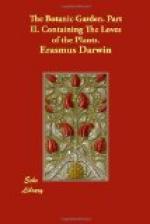P. 8. Addition to the note on Iris. In the Persian Iris the end of the lower petal is purple, with white edges and orange streaks, creeping, as it were, into the mouth of the flower like an insect; by which deception in its native climate it probably prevents a similar insect from plundering it of its honey: the edges of the lower petal lap over those of the upper one, which prevents it from opening too wide on fine days, and facilitates its return at night; whence the rain is excluded, and the air admitted. See Polymorpha, Rubia, and Cypripedia in Vol. I.
P. 12. Additional note on Chandrilla. In the natural state of the expanded flower of the barberry, the stamens lie on the petals; under the concave summits of which the anthers shelter themselves, and in this situation remain perfectly rigid; but on touching the inside of the filament near its base with a fine bristle, or blunt needle, the stamen instantly bends upwards, and the anther, embracing the stigma, sheds its dust. Observations on the Irritation of Vegetables, by T. E. Smith, M. D.
P. 15. Addition to the note on Silene. I saw a plant of the Dionaea Muscipula, Flytrap of Venus, this day, in the collection of Mr. Boothby at Ashbourn-Hall, Derbyshire, Aug. 20th, 1788; and on drawing a straw along the middle of the rib of the leaves as they lay upon the ground round the stem, each of them, in about a second of time, closed and doubled itself up, crossing the thorns over the opposite edge of the leaf, like the teeth of a spring rap-trap: of this plant I was favoured with an elegant coloured drawing, by Miss Maria Jackson of Tarporly, in Cheshire, a Lady who adds much botanical knowledge to many other elegant acquirements. In the Apocynum Androsaemifolium, one kind of Dog’s bane, the anthers converge over the nectaries, which consist of five glandular oval corpuscles surrounding the germ; and at the same time admit air to the nectaries at the interstice between each anther. But when a fly inserts its proboscis between these anthers to plunder the honey, they converge closer, and with such violence as to detain the fly, which thus generally perishes. This account was related to me by R.W. Darwin, Esq; of Elston, in Nottinghamshire, who showed me the plant in flower, July 2d, 1788, with a fly thus held fast by the end of its proboscis, and was well seen by a magnifying lens, and which in vain repeatedly struggled to disengage itself, till the converging anthers were separated by means of a pin: on some days he had observed that almost every flower of this elegant plant had a fly in it thus entangled; and a few weeks afterwards favoured me with his further observations on this subject.




